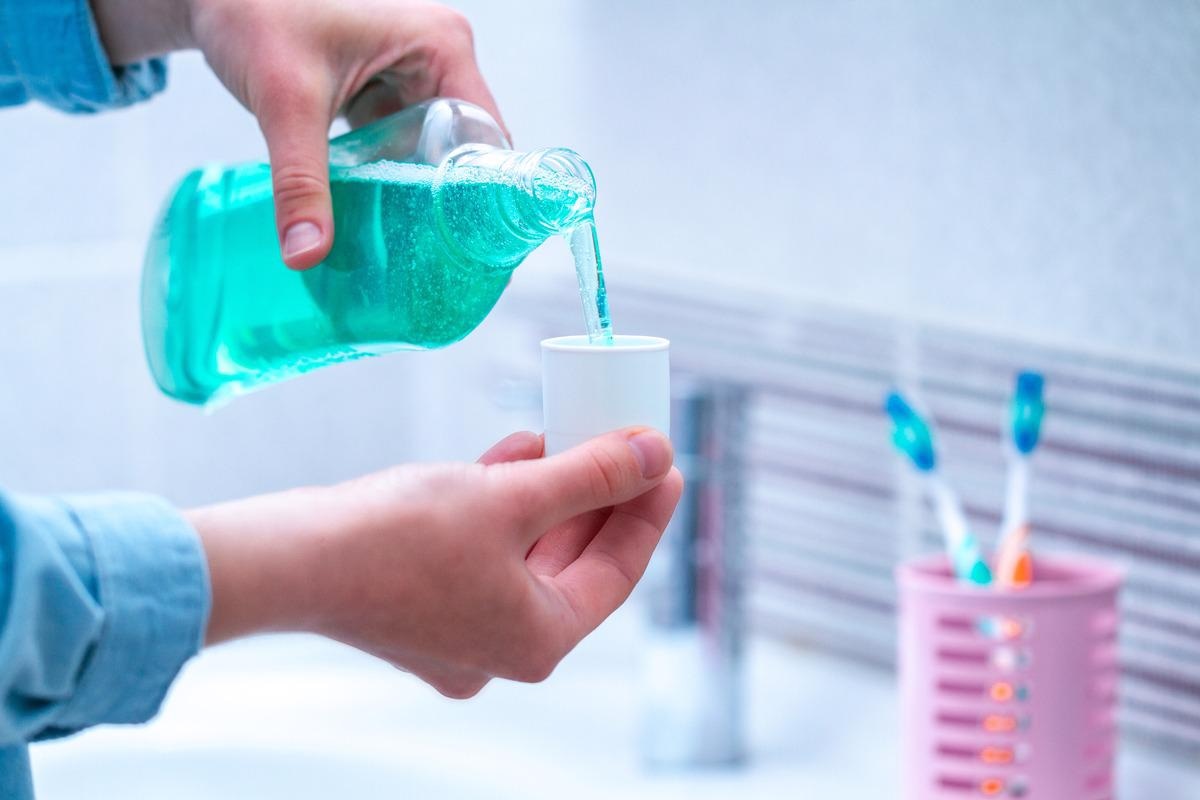In a recent study posted to the medRxiv* preprint server, an interdisciplinary team of researchers from different countries demonstrated the composition and importance of severe acute respiratory syndrome coronavirus 2 (SARS-CoV-2) lipid envelope, and assessed the antiviral potential of oral mouthwashes targeting these lipid envelopes.
 Study: The SARS-CoV2 envelope is distinct from host membranes, exposes pro-coagulant lipids, and can be inactivated in vivo by surfactant-containing oral rinses. Image Credit: goffkein.pro/Shutterstock
Study: The SARS-CoV2 envelope is distinct from host membranes, exposes pro-coagulant lipids, and can be inactivated in vivo by surfactant-containing oral rinses. Image Credit: goffkein.pro/Shutterstock
Unlike the SARS-CoV-2 proteins, little data is available on the lipid composition of the SARS-CoV-2 envelope to date. Except for the use of soaps and sanitizers for hand hygiene amid the coronavirus disease 2019 (COVID-19) pandemic, there is a scarcity of antiviral agents targeting the lipid envelope.
SARS-CoV-2, due to the presence of lipid envelope, may be vulnerable to inactivation by lipid disrupting constituents available in oral mouthwashes such as cetylpyridinium chloride (CPC), ethanol, essential oils, and povidone-iodine (PVP-I). However, the efficacy of these mouthwashes in vivo is unknown.
To address this information gap, the researchers in the current study characterized the SARS-CoV-2 lipid envelope, assessed the antiviral activity of different lipid disrupting mouthwash formulations and their constituents, and finally estimated the efficacy of mouthwash-containing surfactants through randomized clinical study in hospitalized COVID-19 patients.
Study design
In the current study, VeroE6 and A549 cell lines were used for performing virucidal assays. These cell lines were transduced with lentiviruses encoding angiotensin-converting enzyme 2 (ACE2) and transmembrane protease serine 2 (TMPRSS2) for increasing infectivity and development of a sensitive cell line for virus detection. Cell lines were infected with SARS-CoV-2 and virus particles were harvested.
The purity and abundance were estimated using Nanocyte (tracking analysis for nanoparticles) and western blot. The researchers performed lipid extraction of virus particles for lipidomics profiling. Lipidomics provide information regarding the molecular diversity and content of lipid envelopes and external-facing amino phospholipids (aPL).
Targeted quantification of lipids of different categories like phosphatidylinositol (PI), sphingolipids (SL), free cholesterol, cholesterol esters (CE) were performed using hydrophilic interaction liquid chromatography liquid chromatography-tandem mass spectrometry (HILIC LC-MS/MS). Liquid chromatography was used for untargeted lipidomics using three separate preparations of VeroE6 cells. External-facing total phosphatidylethanolamine (PE) and phosphatidylserine (PS) were also identified and quantized using LC/MS-MS. Coagulation activity was estimated by measuring activated partial thromboplastin time (APTT). The purity of gradient viruses was assessed through western blotting.
Lastly, a four-arm randomized controlled trial was conducted to study the effectiveness of different mouthwashes with primary and secondary endpoints of SARS-CoV-2 viral load at 30 and 60 min, respectively.
Findings
The researchers observed that the SARS-CoV-2 strain from England when grown in VeroE6 or A549 cell culture showed a purity at 100nm with a single peak. The team illustrated that the SARS-CoV-2 viral envelope was composed of phospholipids (PL) from different categories with a high relative abundance of phosphatidylcholine (PC), PE, and PI along with their lyso and ether/plasmalogen derivatives and low abundance of sphingolipids like ceramide (Cer), dihydroceramide (DHCer), sphingomyelin (SM) and further cholesteryl esters (CE), triacylglycerides (TAG), and free cholesterol in both cultures. The abundance of ether PEs was high as compared to acyl PEs.
The researchers noted that there was a higher percentage of PI vs PC, a higher ether PE (PE-O) ratio, and fewer PC and diacylPE in A549 cells as compared to VeroE6 cell culture. In the SARS-CoV-2 membrane, a similar ratio of cholesterol: PL was observed for both A549 (0.0005 mol: mol), and VeroE6 cells (0.00061 mol: mol) indicating the absence of cholesterol and high content of PL. A relatively low mol% of SM and PS were also observed.
Lipidomic data revealed the presence of high levels of PL specifically PE, PC, and PI, and low levels of PS, cholesterol, and SM in the SARS-CoV-2 membrane. The researchers interpreted the association of detected specific lipid molecular species and host cell origin for determining the membrane composition.
The researchers determined the percentage of PE and PS on the viral particle surface and observed that the levels of external aPL for A549 and Vero cells were 48% and 52%, respectively, while PS % externalized were 56% and 27%, respectively. For both cell types, overall external levels of PE were 52%.
The team demonstrated that at a minimum concentration of ~6×105 plaque-forming unit (PFU)/ml, the SARS-CoV-2 virion dramatically reduced APTT in a concentration-dependent manner.
The team demonstrated that five of the seven oral rinses studied when added undiluted reduced host cell viability, which was concentration-dependent and reduced by serial dilution. Among the different mouthwashes tested, two types of mouthwashes containing CPC (dentyl dual action and dentyl fresh protect) and one containing 23% v/v ethanol caused >5-log10 reduction in viral titers eradicating the virus completely and hence met the EN14476 virucidal standards. While PVP-I (Videne), sodium citric acid/benzoate/CPC, and 21% v/v alcohol-based mouthwash (Listerine) showed moderate effects with the reduction of ~3-log fold and failed to meet the EN14476 standard. Chlorhexidine with <2 log fold reduction was the least effective.
The researchers observed an eight-fold difference between the virucidal mouthwashes -CPC (Dentyl fresh protect) and ethanol/LAE (Listerine) in in vitro cell toxicity using VeroE6 cells. On the cultured VeroE6 cells, Listerine exhibited higher virus selectivity and showed two times more potent inhibitory concentration 50 (IC50) values of virus inactivation as compared to the Dentyl fresh product.
The team noted the potential impact of the charge on surfactants on interaction with lipid membrane with cationic (CPC and ethyl lauroyl arginate (LAE)) and anionic surfactant (dodecylbenzene sulfonate (DBS)) completely eradicated infectivity while additional constituents dampening effectiveness in SARS-CoV-2 inactivation.
All four types of mouthwashes analyzed in the study decreased viral salivary load one minute after rinsing, with the largest reduction of dentyl dual action (median 14.3 log2 reduction from baseline) and the smallest in normasol (median 3.9 log2 fold reduction from baseline).
Conclusion
The findings of this study demonstrated that the lipid envelope of SARS-CoV-2 is distinct from the plasma membrane of the host which enables the design of specific anti-viral therapies. Several types of mouthwashes containing membrane disrupting surfactants showed notable antiviral efficacy. Mouthwashes containing surfactants like CPC were more effective than PVP-I in vivo and eliminated live viruses.
The study enhanced our understanding of SARS-CoV-2 pathogenesis, dissemination, and transition from early infection to thrombotic severe COVID-19 based on lipid envelope structure. It further suggested that during this pandemic, surfactants containing mouthwashes have the potential to minimize transmission risk. The authors warrant the need for population-based studies on a large scale to estimate the effect.
*Important notice
medRxiv publishes preliminary scientific reports that are not peer-reviewed and, therefore, should not be regarded as conclusive, guide clinical practice/health-related behavior, or treated as established information.
- Zack Saud,et al. (2022). The SARS-CoV2 envelope is distinct from host membranes, exposes pro-coagulant lipids, and can be inactivated in vivo by surfactant-containing oral rinses.medRxiv. doi: https://doi.org/10.1101/2022.02.16.22270842 https://www.medrxiv.org/content/10.1101/2022.02.16.22270842v1
Posted in: Medical Research News | Medical Condition News | Disease/Infection News
Tags: ACE2, Alcohol, Angiotensin, Angiotensin-Converting Enzyme 2, Cell, Cell Culture, Cell Line, Cholesterol, Chromatography, Coronavirus, Coronavirus Disease COVID-19, covid-19, Efficacy, Enzyme, Esters, Ethanol, Hygiene, in vitro, in vivo, LC/MS, Lipidomics, Lipids, Liquid Chromatography, Mass Spectrometry, Membrane, Mouthwash, Nanoparticles, Pandemic, Respiratory, SARS, SARS-CoV-2, Serine, Severe Acute Respiratory, Severe Acute Respiratory Syndrome, Spectrometry, Syndrome, Virus, Western Blot

Written by
Sangeeta Paul
Sangeeta Paul is a researcher and medical writer based in Gurugram, India. Her academic background is in Pharmacy; she has a Bachelor’s in Pharmacy, a Master’s in Pharmacy (Pharmacology), and Ph.D. in Pharmacology from Banasthali Vidyapith, Rajasthan, India. She also holds a post-graduate diploma in Drug regulatory affairs from Jamia Hamdard, New Delhi, and a post-graduate diploma in Intellectual Property Rights, IGNOU, India.
Source: Read Full Article